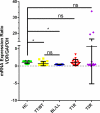VDR polymorphism, gene expression and vitamin D levels in leprosy patients from North Indian population
- PMID: 30481178
- PMCID: PMC6286024
- DOI: 10.1371/journal.pntd.0006823
VDR polymorphism, gene expression and vitamin D levels in leprosy patients from North Indian population
Abstract
Background: Leprosy is a chronic infectious disease caused by Mycobacterium leprae and mainly affects skin, peripheral nerves. Vitamin D receptor (VDR) gene polymorphism has been found to be associated with leprosy. Vitamin D has been shown to control several host immunomodulating properties through VDR gene. Vitamin D deficiency was also found to be linked to an increased risk for several infections and metabolic diseases.
Objective: In the present study, we investigated the association of VDR gene polymorphism, mRNA gene expression of VDR and the vitamin D levels with leprosy and its reactional states.
Methodology: A total of 305 leprosy patients consisting of tuberculoid (TT), borderline tuberculoid (BT), borderline lepromatous (BL), lepromatous leprosy (LL), as well as 200 healthy controls were enrolled in the study. We identified single nucleotide polymorphisms (SNPs) of VDR Taq1, Fok1 and Apa1, as well as the expression of VDR mRNA gene using PCR-based restriction fragment length polymorphism (RFLP) analysis and real-time PCR respectively. We also performed ELISA to measure vitamin D levels.
Result: We observed that SNP of VDR gene (Fok1 and Taq1) are associated with the leprosy disease. The allelic frequency distribution of T and t allele (p = 0.0037), F and f allele (p = 0.0024) was significantly higher in leprosy patients and healthy controls. ff genotype of Fok1 was found to be associated with leprosy patients [p = 0.0004; OR (95% CI) 3.148 (1.662-5.965)]. The recessive model of Fok1 genotype was also found to be significantly associated in leprosy patients in comparison to healthy controls [p = 0.00004; OR (95% CI) 2.85 (1.56-5.22)]. Leprosy patients are significantly associated with t-F-a haplotype. Further, VDR gene expression was found to be lower in non-reaction group compared to that of reaction group of leprosy and healthy controls. Paradoxically, we noted no difference in the levels of vitamin D between leprosy patients and healthy controls.
Conclusion: Blood levels of vitamin D do not play any role in clinical manifestations of any forms of leprosy. ff genotype of Fok1 and tt genotype of Taq1 was found to be associated with leprosy per se. Association of t-F-a haplotype with leprosy was found to be significant and could be used as a genetic marker to identify individuals at high risk for developing leprosy. VDR gene expression was lower in TT/BT and BL/LL groups of leprosy in comparison to that of healthy controls.
Conflict of interest statement
The authors have declared that no competing interests exist.
Figures


Similar articles
-
Association of Fok1 VDR polymorphism with Vitamin D and its associated molecules in pulmonary tuberculosis patients and their household contacts.Sci Rep. 2019 Oct 24;9(1):15251. doi: 10.1038/s41598-019-51803-8. Sci Rep. 2019. PMID: 31649297 Free PMC article.
-
Serum vitamin D levels and gene polymorphisms (Fok1 and Apa1) in children with type I diabetes and healthy controls.J Pak Med Assoc. 2016 Oct;66(10):1215-1220. J Pak Med Assoc. 2016. PMID: 27686292
-
Association of Taq I, Fok I and Apa I polymorphisms in Vitamin D Receptor (VDR) gene with leprosy.Hum Immunol. 2015 Jun;76(6):402-5. doi: 10.1016/j.humimm.2015.04.002. Epub 2015 Apr 15. Hum Immunol. 2015. PMID: 25890006
-
Vitamin D Receptor Polymorphisms and Cancer.Adv Exp Med Biol. 2020;1268:53-114. doi: 10.1007/978-3-030-46227-7_4. Adv Exp Med Biol. 2020. PMID: 32918214
-
[The impact of VDR gene polymorphisms on obesity, metabolic changes, bone mass disorders and neoplastic processes].Pediatr Endocrinol Diabetes Metab. 2018;24(2):96-105. doi: 10.18544/PEDM-24.02.0108. Pediatr Endocrinol Diabetes Metab. 2018. PMID: 30300431 Review. Polish.
Cited by
-
Vitamin D Receptor Gene Polymorphisms Are Associated With Leprosy in Southern Brazil.Front Immunol. 2019 Oct 4;10:2157. doi: 10.3389/fimmu.2019.02157. eCollection 2019. Front Immunol. 2019. PMID: 31636627 Free PMC article.
-
Leprosy: A rare case of infectious peripheral neuropathy in the United States.IDCases. 2020 Apr 14;20:e00765. doi: 10.1016/j.idcr.2020.e00765. eCollection 2020. IDCases. 2020. PMID: 32382502 Free PMC article.
-
A systematic review and meta-analysis of the association between neglected tropical diseases and malnutrition: more research needed on diseases other than intestinal parasites, leishmaniasis and leprosy.Access Microbiol. 2024 Nov 13;6(11):000800.v3. doi: 10.1099/acmi.0.000800.v3. eCollection 2024. Access Microbiol. 2024. PMID: 39539349 Free PMC article.
-
Leprosy: treatment, prevention, immune response and gene function.Front Immunol. 2024 Feb 19;15:1298749. doi: 10.3389/fimmu.2024.1298749. eCollection 2024. Front Immunol. 2024. PMID: 38440733 Free PMC article. Review.
-
Vitamin B12 and D3 Levels in Leprosy Patients With or Without Deformity: A Cross-Sectional, Analytic Study.Cureus. 2025 Jun 4;17(6):e85376. doi: 10.7759/cureus.85376. eCollection 2025 Jun. Cureus. 2025. PMID: 40621222 Free PMC article.
References
-
- Kaplan G. Recent advances in cytokine therapy in leprosy. J Infect Dis. 1993; 167: 18–22. - PubMed
-
- Britton WJ, Lockwood DN. Leprosy. Lancet 2004; 363: 1209–19. 10.1016/S0140-6736(04)15952-7 - DOI - PubMed
-
- Alter A, Huong NT, Singh M, Orlova M, Van Thuc N, Katoch K, et al. Human leukocyte antigen class I region single nucleotide polymorphisms are associated with leprosy susceptibility in Vietnam and India. J Infect Dis. 2011; 203: 1274–81. 10.1093/infdis/jir024 - DOI - PMC - PubMed
-
- Fitness J, Tosh K, Hill AV. Genetics of susceptibility to leprosy. Genes Immun. 2002; 3: 441–53. 10.1038/sj.gene.6363926 - DOI - PubMed
-
- Moraes MO, Cardoso CC, Vanderborght PR, Pacheco AG. Genetics of host response in leprosy. Lepr Rev. 2006; 77(3): 189–202. - PubMed
Publication types
MeSH terms
Substances
LinkOut - more resources
Full Text Sources
Medical

